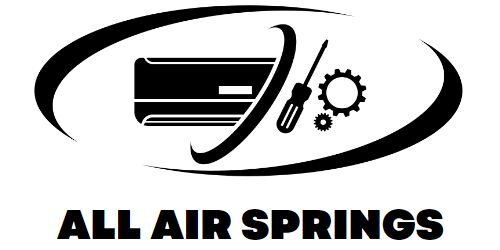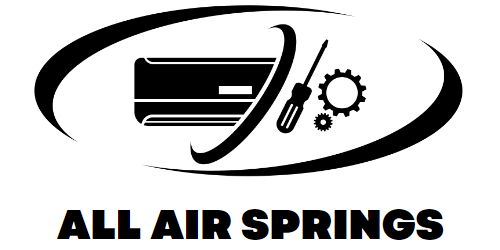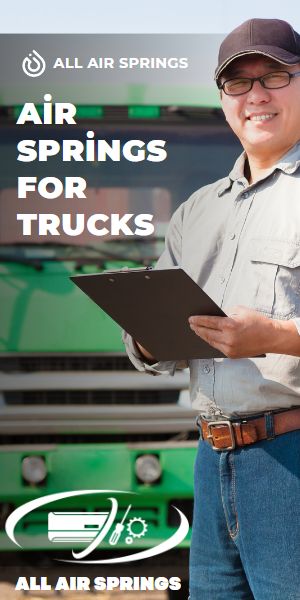The Complete Guide to Commercial Truck Air Springs: Benefits, Maintenance, and Future Trends
Introduction to Commercial Truck Air Springs
Air springs are an essential component of the suspension system in commercial trucks. They serve as a cushion between the vehicle’s chassis and its axles, using air pressure to absorb shocks and vibrations. Unlike traditional metal coil springs, air springs utilize compressed air to provide a smoother and more flexible ride. This innovative technology has become increasingly popular due to its numerous benefits, such as better load distribution, improved ride quality, and enhanced safety.
The primary function of air springs is to ensure the truck can handle heavy loads while maintaining a stable, controlled ride. When properly maintained, they can reduce wear and tear on the vehicle’s frame and other suspension components, resulting in fewer repairs and a longer lifespan for the truck.
Air springs play a crucial role in commercial trucks by enhancing comfort for drivers and preventing cargo from shifting during transport. This makes them an indispensable part of the modern trucking industry, especially for long-haul routes where consistent ride quality is paramount.
In the following chapters, we’ll explore how air springs work, their benefits, maintenance practices, and more.
How Air Springs Work in Commercial Trucks
Air springs are designed to provide a smooth and stable ride by adapting to various road conditions and load weights. At the core of this technology is the use of compressed air, which offers more flexibility than traditional metal springs. An air spring consists of three main components: the air bag, a piston or diaphragm, and the suspension system.
The air bag is typically made of a durable, flexible rubber material that can expand and contract. This air bag is inflated with compressed air to create a cushion between the truck’s chassis and the axle. As the truck encounters bumps or rough roads, the air inside the bag absorbs the impact, helping to minimize the jarring effect felt by the driver and the cargo.
When the truck is loaded, the air springs adjust the air pressure inside the bags to accommodate the weight, providing a more even distribution of the load. This flexibility also allows the suspension system to maintain a constant ride height, regardless of the weight fluctuations during the journey.
The pistons or diaphragms inside the air springs control the air flow and pressure, ensuring optimal comfort and safety. Together with the truck’s other suspension components, air springs help to ensure a smooth, efficient ride for both the vehicle and the cargo.
Benefits of Air Springs for Commercial Trucks
Air springs offer a wide range of benefits that enhance the performance and efficiency of commercial trucks. One of the most significant advantages is the
improved ride quality
. By absorbing road shocks and vibrations, air springs provide a smoother and more comfortable ride for drivers, especially over long distances or rough terrain. This leads to less driver fatigue and a more pleasant driving experience.
Another key benefit is better load management. Air springs help maintain a consistent ride height, which ensures that the truck’s weight is evenly distributed across the axles. This results in better load balancing, reducing the risk of cargo shifting during transit. This not only improves safety but also minimizes the wear on cargo and the vehicle.
Extended tire life is another significant advantage. Air springs help reduce the strain on tires by distributing the weight more evenly, preventing excessive wear and tear on individual tires. This, in turn, leads to lower maintenance costs and longer-lasting tires.
Furthermore, air springs enhance fuel efficiency. A smoother ride means the engine doesn’t have to work as hard to counteract the shocks and bumps on the road, which can result in better overall fuel economy. This makes air springs a cost-effective solution for fleet owners looking to reduce operational costs.
In summary, air springs contribute to a more comfortable, efficient, and cost-effective experience for commercial truck drivers and fleet managers alike.
Types of Air Springs in Commercial Trucks
There are several types of air springs used in commercial trucks, each designed to cater to different needs and requirements. Understanding the different types will help truck owners and fleet managers choose the most suitable option for their vehicles.
-
Bellows Air Springs
Bellows air springs are among the most common types found in commercial trucks. They have a flexible, bellows-shaped design, which allows them to expand and contract when compressed air is added. This design provides excellent cushioning and load support, making them ideal for heavy-duty trucks. Bellows air springs offer smooth ride quality and adaptability to varying road conditions.
-
Convoluted Air Springs
Convoluted air springs have a series of folds or convolutions in their design. These folds allow the air spring to compress and expand more efficiently, offering a greater range of motion than bellows air springs. Convoluted air springs are often used in applications that require higher load capacities and more extreme conditions. They provide a higher level of durability and can handle rougher roads and heavy loads without compromising performance. -
Sleeve Air Springs
Sleeve air springs have a cylindrical design with a sleeve that fits over the piston. They are particularly useful for applications where space is limited, as their compact design allows them to be installed in tight areas. Sleeve air springs provide consistent ride height and are ideal for vehicles that experience frequent load shifts or need extra cushioning for sensitive cargo.
Each type of air spring has its own set of advantages, and the best choice will depend on the truck’s intended use, load requirements, and road conditions. Understanding these differences can help ensure optimal performance and longevity of the air suspension system.
Air Spring Maintenance and Care
Proper maintenance and care of air springs are essential to ensure their longevity and optimal performance in commercial trucks. By taking a proactive approach to maintenance, fleet managers can prevent costly repairs and keep trucks running smoothly for longer periods.
One of the most critical aspects of air spring maintenance is regularly checking the
air pressure
. Air springs rely on the correct amount of pressure to function properly, and underinflated or overinflated air bags can lead to uneven ride quality, excessive wear, or even failure. It’s important to follow the manufacturer’s recommendations for air pressure and check the system periodically, especially before long trips.
Regular inspections are also crucial to identify any signs of damage, wear, or leaks. Inspect the air bags for any cracks, punctures, or abrasions, and look for any issues with the mounting brackets or other components. Any small leak or damage should be addressed immediately to avoid larger, more expensive problems down the line.
Additionally, avoiding overloading the truck is key to maintaining air springs. Overloading can cause the air springs to be under constant strain, leading to premature wear and potential failure. It’s essential to ensure that the vehicle is not carrying more weight than it was designed to handle.
Lastly, keeping the air spring system clean and free from debris can help prevent blockages in the air lines and maintain optimal air flow. By following these simple maintenance steps, truck owners can ensure that their air springs remain in excellent condition, providing a smoother and safer ride for the long haul.
Common Issues with Commercial Truck Air Springs
Despite their durability and efficiency, air springs in commercial trucks can experience a variety of issues over time. Recognizing and addressing these problems early can help prevent more serious damage and keep the vehicle in top working condition.
One of the most common issues with air springs is
air leaks
. Air leaks can occur at the air bag itself, the fittings, or the air lines. A slow air leak can lead to a loss of pressure, resulting in a rougher ride and reduced load support. To identify air leaks, drivers and fleet managers can listen for hissing sounds or check for visible signs of air escaping. Additionally, regular air pressure checks can help detect small leaks before they become more severe.
Another common issue is punctures or tears in the air spring material. These can be caused by debris on the road, rough terrain, or improper installation. A punctured air spring can significantly reduce the effectiveness of the suspension system and compromise vehicle performance. It’s important to inspect the air springs regularly for any visible signs of damage.
Uneven ride height is another issue that may arise if the air springs are not functioning properly. If one or more air springs are leaking or damaged, the truck may sag on one side, affecting the overall stability and safety of the vehicle. This can lead to further mechanical issues, including misalignment of tires or suspension components.
Lastly, worn-out or damaged components such as the pistons, brackets, or air valves can also affect the performance of air springs. Regular inspections and timely replacements of these parts can prevent more serious problems from developing.
By staying vigilant and addressing these common issues, truck owners can ensure their air spring systems continue to operate efficiently and safely, keeping their vehicles in peak condition.
Choosing the Right Air Spring System for Your Truck
Selecting the appropriate air spring system for your commercial truck is crucial for optimizing performance, comfort, and safety. Several factors should be considered when choosing an air spring system to ensure it meets the specific needs of your vehicle and operation.
1.
Truck Size and Weight Requirements
The first consideration is the size and weight of your truck. Larger, heavier trucks require more robust air springs that can handle higher loads and provide adequate support. Ensure the air spring system you choose can accommodate your vehicle’s weight capacity and operating conditions. This is especially important for trucks used in heavy-duty applications, such as transporting large equipment or materials.
2. Load Distribution and Ride Quality
If your truck frequently hauls heavy or uneven loads, a system that provides better load distribution is essential. Air springs help maintain a constant ride height and evenly distribute the load across the axles. Look for systems designed for better ride quality, especially if you’re concerned about driver comfort and cargo protection on long hauls or bumpy roads.
3. Durability and Maintenance Needs
The durability of the air spring system is another critical factor. Opt for high-quality, durable materials that can withstand harsh road conditions and extreme temperatures. Consider the maintenance requirements of the system as well. Some air springs are designed for minimal maintenance, while others may require more frequent checks and servicing.
4. Compatibility with Existing Suspension System
It’s important to ensure that the air spring system is compatible with your truck’s existing suspension. Some systems are designed to be retrofitted, while others work best with specific types of suspension setups. Check the manufacturer’s specifications to ensure compatibility and avoid costly modifications.
5. Manufacturer Reputation and Warranty
Choose a reputable manufacturer with a history of producing high-quality air spring systems for commercial trucks. A solid warranty can provide peace of mind, ensuring that any potential defects or issues with the system are covered. Look for systems that come with comprehensive warranties to protect your investment.
By considering these factors, you can choose the right air spring system that enhances your truck’s performance, extends its lifespan, and improves overall safety and comfort.
Future Trends in Air Spring Technology for Commercial Trucks
As technology continues to evolve, air spring systems for commercial trucks are becoming more advanced, offering greater efficiency, safety, and performance. The future of air spring technology is exciting, with several trends on the horizon that could significantly impact the trucking industry.
1.
Smart Air Springs and Sensors
One of the most promising developments is the integration of smart air springs with sensors and onboard computer systems. These smart systems can monitor and adjust the air pressure in real time, automatically adapting to changing road conditions, load variations, and vehicle speed. This not only ensures a smoother ride but also improves fuel efficiency and reduces wear on the truck’s components. Sensors can also detect issues such as leaks or damage and alert the driver or fleet manager for timely maintenance.
2. Automatic Load Balancing
The future of air spring technology also includes automatic load balancing. In this system, air springs adjust their pressure to maintain an optimal ride height regardless of load changes. For trucks that frequently transport varying cargo, this technology ensures that the vehicle remains level at all times, improving stability, handling, and ride comfort. It also reduces stress on suspension components, extending the overall lifespan of the vehicle.
3. Electric and Autonomous Vehicles
As the trucking industry moves toward electric and autonomous vehicles, air spring systems will need to adapt to the unique requirements of these vehicles. Electric trucks, in particular, may require air spring systems that can handle heavier battery packs and provide more precise control of the ride quality. Autonomous trucks will benefit from air spring systems that can adjust automatically, responding to changing road conditions without human intervention.
4. Enhanced Durability and Eco-Friendly Materials
Another trend is the development of more durable and eco-friendly materials for air springs. Manufacturers are focusing on creating materials that can withstand extreme weather conditions, while also being more sustainable. The use of recycled materials or innovations in rubber compounds may lead to air springs that are both longer-lasting and more environmentally friendly.
5. Integration with Fleet Management Systems
The integration of air spring systems with fleet management software is another trend to watch. By linking air spring performance data with real-time tracking systems, fleet managers can monitor the health of their air suspension systems and schedule maintenance more efficiently. This technology allows for better predictive maintenance and ensures that vehicles are always operating at peak performance.
These emerging trends in air spring technology promise to make commercial trucks safer, more efficient, and more reliable. As the trucking industry continues to innovate, air springs will play an increasingly important role in shaping the future of transportation.
For detailed information, you can contact us at torqueusa.com


